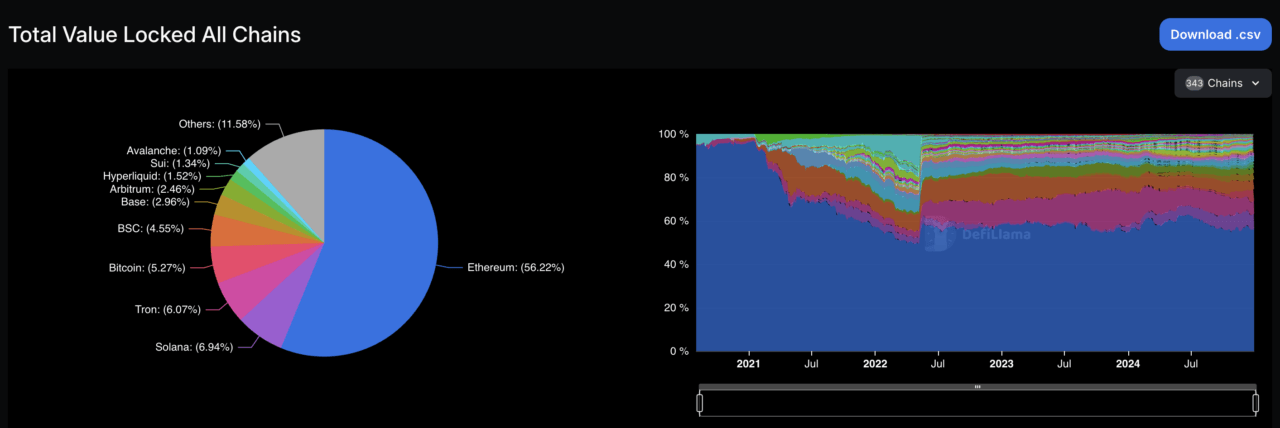As blockchain technology continues to evolve, understanding user engagement is crucial to assessing the success of any network. One particularly insightful metric is daily active addresses. This refers to the number of unique blockchain addresses that participate in transactions on a given day, whether by sending or receiving assets. Essentially, it provides a snapshot of how many users are actively interacting with a blockchain at any given time, making it a reliable measure of real-world usage and popularity.
On Dec. 27, 2024, CryptoRank published a chart ranking the top 10 blockchains of the year based on their average daily active addresses. This data, sourced from CryptoRank and Artemis.xyz, highlights some fascinating trends in blockchain adoption and offers insights into the platforms that led the way in driving user engagement. Let’s delve into the top three blockchains dominating this metric, followed by a quick overview of the remaining networks in the top 10.
1. NEAR Protocol: 2.7 Million Daily Active Addresses (+766% YoY)
NEAR Protocol emerged as the leader in 2024, boasting 2.7 million daily active addresses. This marks an astounding 766% year-on-year growth, largely driven by its focus on scalability and user-friendly tools for developers. NEAR employs an innovative sharding technology called Nightshade, which splits the blockchain into smaller, more manageable pieces, enabling high transaction throughput at low costs. This efficiency has made NEAR a top choice for developers creating decentralized applications (dApps).
NEAR’s success was further bolstered by the rapid adoption of blockchain-based gaming and social dApps on its platform. These applications attracted new users unfamiliar with blockchain technology, helping NEAR build a robust and growing ecosystem. Combined with significant investments from the NEAR Foundation in developer grants, the protocol’s rise to the top underscores its appeal to both users and builders alike.
2. Solana: 2.6 Million Daily Active Addresses (+702% YoY)
Solana ranked second, with 2.6 million daily active addresses and an impressive 702% year-on-year growth. The network’s popularity in 2024 was fueled largely by its vibrant memecoin ecosystem, which saw massive trading activity on platforms like Pump.fun. These memecoins attracted retail and institutional investors alike, significantly boosting Solana’s usage metrics.
In addition to memecoins, Solana’s high-speed, low-cost infrastructure made it a go-to blockchain for decentralized finance (DeFi) and non-fungible token (NFT) projects. Developers and users flocked to the network to take advantage of its efficiency, while institutional interest grew as Solana proved its scalability and reliability. This combination of factors cemented Solana as one of the top blockchains of the year.
3. TRON: 1.9 Million Daily Active Addresses (+20.3% YoY)
TRON secured the third spot with 1.9 million daily active addresses, representing a steady 20.3% growth compared to the previous year. TRON’s dominance in stablecoin transactions, especially those involving Tether (USDT), has been a key driver of its user base. With low transaction fees and high-speed transfers, TRON became a preferred platform for users seeking seamless, cost-effective stablecoin operations.
The blockchain also maintained a strong presence in the decentralized finance (DeFi) sector, partnering with various global payment systems and financial institutions. While its growth was not as dramatic as NEAR or Solana, TRON’s consistent performance and utility ensured its place among the top blockchains of 2024.
A Quick Look at the Rest of the Top 10
Beyond the top three, the remaining blockchains on the list showcased diverse strengths and challenges.
BNB Chain saw 1 million daily active addresses, a slight decline of 4.8% from the previous year. Despite the drop, BNB Chain remains a hub for DeFi and token trading, retaining its importance in the blockchain ecosystem.
Polygon (MATIC) recorded 855,000 daily active addresses, achieving a robust 139% year-on-year growth. As a Layer 2 scaling solution for Ethereum, Polygon continues to attract gaming, NFT, and DeFi projects, solidifying its role as a vital part of Ethereum’s ecosystem.
Base, Coinbase’s Layer 2 solution, achieved 655,000 daily active addresses, experiencing an exceptional 2,098% year-on-year growth. Its close integration with Ethereum and Coinbase’s user-friendly platform have significantly boosted its adoption.
Sui emerged as a standout performer with 519,000 daily active addresses, experiencing an extraordinary 908% year-on-year increase. This growth is attributed to its innovative programming language and rapidly expanding ecosystem of decentralized applications (dApps).
Bitcoin (BTC), the world’s most recognized blockchain, recorded 496,000 daily active addresses, a 19% decline year-on-year. While Bitcoin remains the dominant asset in terms of market capitalization, its decrease in daily active addresses reflects shifting user priorities.
The Open Network (TON), the blockchain associated with Telegram, experienced exponential growth in 2024, with daily active addresses surging by 5,185% to reach 414,000. This growth was fueled by TON’s integration with Telegram, leveraging the messaging platform’s massive user base to boost adoption.
Finally, Arbitrum, a leading Ethereum Layer 2 solution, achieved 413,000 daily active addresses, a 180% increase year-on-year. Arbitrum’s ability to scale Ethereum applications while maintaining low fees and high throughput has made it a key player in the Ethereum ecosystem.
Comparing Activity with Total Value Locked: A Broader Perspective
An additional lens to evaluate blockchain ecosystems is Total Value Locked (TVL), a metric that reflects the total dollar value of assets locked in decentralized finance (DeFi) protocols on a blockchain. TVL measures how much capital users have committed to DeFi applications, such as lending, staking, and liquidity provision. Unlike daily active addresses, which emphasize user activity, TVL provides insights into the financial depth and maturity of a blockchain’s DeFi ecosystem.
By this measure, Ethereum stands unrivaled, commanding 56.22% of the total TVL across all chains as of Dec. 30, 2024, according to data from DeFiLlama.

Ethereum’s dominance stems from its well-established DeFi ecosystem, which houses the most diverse and advanced set of decentralized applications, supported by its early adoption and a strong developer community. However, Ethereum’s supremacy in TVL contrasts with its position in daily active addresses, where it does not lead. This divergence highlights the differing nature of these metrics: TVL captures capital locked in protocols, which requires fewer but larger transactions, while daily active addresses highlight the frequency of user interactions, often linked to smaller, retail-driven activities.
Solana and TRON, ranked second and third in daily active addresses, hold significantly lower TVL rankings. Solana accounts for 6.94% of total TVL, and TRON makes up 6.07%, placing them behind Ethereum.
The contrast between TVL and daily active addresses highlights the diverse strengths of blockchain networks. While Ethereum excels in financial liquidity and high-value applications, chains like Solana and TRON thrive on user engagement and transaction activity. Together, these metrics provide a more nuanced understanding of the blockchain landscape, showcasing that no single measure can capture the full picture of a network’s adoption and utility.
Featured Image via Pixabay
 cryptoglobe.com
cryptoglobe.com
